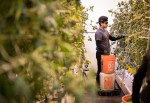Thirty years ago, buying cannabis was difficult, expensive and illegal. Buying cannabis in 2019 is somewhere between picking up a prescription from a pharmacy and buying beer from a liquor store. Join columnist John Tudhope each week as he visits cannabis companies in Los Angeles and discusses the budding industry.
The first time I saw a cannabis plant was at my grandma’s house in my early teens. It was lanky, hidden away and surprisingly harmless for all I’d heard about its dangers – this was the literal embodiment of “homegrown” cannabis.
Last week, I had the opportunity to visit The Cure Company’s 30,000 square foot industrial cultivation facility near Boyle Heights housing thousands of plants, and see the most technical form that cannabis production can take.
Cultivation operations are subject to some of the most stringent regulations in the legal cannabis industry. Growers must only use approved chemicals, implement a comprehensive “seed-to-sale” inventory system and are subject to extreme taxes. In spite – or maybe because of – this bureaucratic spider web, these businesses are able to produce the highest quality cannabis on a massive scale.
While rural Humboldt County in Northern California is still a cultivation hub, as seen in Netflix’s new docuseries “Murder Mountain,” legal grow operations are moving indoors and popping up throughout the state. “Ocean grown” cannabis strains once thrived in the ocean’s morning dew, but now growers make the world’s best OGs, which are widely considered to be strong cannabis strains, by crafting an indoor environment that can replicate the seaside conditions flawlessly.
The Cure Company is an uncommon business in LA because it is one of few companies permitted to cultivate, process and sell directly to consumers, especially in one facility.
Their enormous headquarters, a few miles east of Downtown LA, has eight grow rooms, each housing 400 to 600 plants, producing cannabis on a massive scale. They represent the future of recreational cannabis, which will be, like it or not, mass-produced.
I was permitted rare access to the entirety of their facility, and observed what goes into producing cannabis on a commercial level. While most people don’t see cannabis as much more than dried green leaves in a baggie or canister, this tour gave me an in-depth look at the transformation of an unassuming shrub into a consumable product that people have fought for decades to consume, buy and sell legally.
The plants begin life as seeds or are rooted from a cutting taken from a mature plant. Seedlings at The Cure Company begin their life in a nursery housed in one of the eight grow rooms. The plants are moved into other grow rooms as they reach maturity so that the environment and nutrients can be tailored to the specific needs of each cannabis variety.
I walked from room to room with master grower Joe Bermejo, and as I stepped into the fluorescent blue and dim orange grow rooms, each space had a distinct and pungent aroma. The first grow room we entered had a wooden, earthy scent, while another smelled particularly sweet. Bermejo said the terpenes, compounds in each cannabis strain, are responsible for giving the plants a distinctive smell, though each strain has a wildly different odor profile.
As Bermejo spoke about the properties of the plants under his care, he reminded me most of a sommelier, both in a scientific and imaginative way. He brought the cannabis to his nose in the same way a seasoned wine drinker would, inhaled deeply and analyzed the sweet scent or the skunky odor.
As we walked through the facility, I saw employees pruning plants for harvest, sifting through piles of dried cannabis and interacting with customers in the company store. The retail space had a variety of in-house products alongside cannabis from the company’s competitors. Gloria Chavez, an administrator at The Cure Company, says that while companies compete at the cultivation level, they must carry the range of products that consumers are looking for in order to succeed in retail.
Throughout the tour, it was obvious that both Chavez and Bermejo were extremely proud of the cultivation system set up at The Cure Company, as well as the full legal compliance of each and every minute detail of their operation. Coming from an industry that has been largely illegal, unregulated and underground, it seemed to me that The Cure Company was particularly fond of representing a new type of fully compliant and technically advanced cannabis business.
Now, I would be lying if I said I wasn’t given an opportunity to try the product, and I would be lying if I didn’t say it was of the highest quality. Chavez mentioned that their cannabis is testing at 34 percent THC levels, which is unprecedented for a high-THC cannabis strain. The atmosphere of this operation was professional, industrial and nothing like the hippies that grew your uncle’s weed.
